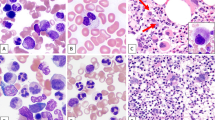Abstract
To define better the chromosomal profile of atypical chronic lymphocytic leukemia (aCLL), cytogenetic and interphase cytogenetic studies were performed in 43 cases, using mitogen-stimulated cultures and DNA probes detecting the two most frequently occurring aberrations in CLL, ie +12 and 13q14 deletions. All cases showed monoclonal CD5/CD19-positive lymphocytosis, with more than 10% large lymphocytes and/or prolymphocytes in peripheral blood smears and reactivity with FMC7, or bright expression of surface immunoglobulins in a fraction of the cases. Karyotype aberrations were detected in 27 of 43 cases (62.8%). Recurrent chromosome changes were +12 (nine cases), 13q14 aberrations (five cases), 11q anomalies (three cases), 6q21-q23 abnormalities and 4q anomalies with different breakpoints (two cases each). Additional chromosome changes were seen in four cases with +12, in three cases with 13q14 anomalies, in two cases with 11q anomalies, in one case with 6q and 4q anomalies. Trisomy 12 was associated with 13q14 anomalies in three cases, one of which also had an 11q abnormality; other associations, found in one case each, were: 13q14 deletion with a 6q anomaly, 11q anomaly with 13q− and 7q−, a 6q anomaly with 7q− and +12. Interphase cytogenetics confirmed the results of chromosome banding analysis and showed that six patients with normal karyotype or no mitosis in fact had concomitant +12 and 13q14 deletion in four cases and isolated +12 or 13q14 deletion in one case each, with a resultant 76% overall incidence of cytogenetic abnormalities. The presence of +12, 13q14 deletions, 11q, and 6q21-q23 anomalies in 19 cases was associated with a 2-month median interval between diagnosis and start of treatment, as compared with a 24-month median interval in 14 cases with normal karyotype or non-recurrent chromosome changes (P = 0.003). We conclude that aCLL is characterized by a relatively high incidence of chromosome anomalies, with recurrent chromosome changes, involving chromosomes 12, 13q14, 6q21q23, 11q, and, possibly, 4q. The presence of complex karyotypes, with concomitant abnormalities of 13q, +12, 6q, 11q, suggests that the development of sequential chromosome changes, rather than any single specific anomaly, may underlie leukemogenesis in this cytologic subset of CLL, partially accounting for the relatively aggressive clinical course.
This is a preview of subscription content, access via your institution
Access options
Subscribe to this journal
Receive 12 print issues and online access
$259.00 per year
only $21.58 per issue
Buy this article
- Purchase on Springer Link
- Instant access to full article PDF
Prices may be subject to local taxes which are calculated during checkout
Similar content being viewed by others
Author information
Authors and Affiliations
Rights and permissions
About this article
Cite this article
Bigoni, R., Cuneo, A., Roberti, M. et al. Chromosome aberrations in atypical chronic lymphocytic leukemia: a cytogenetic and interphase cytogenetic study. Leukemia 11, 1933–1940 (1997). https://doi.org/10.1038/sj.leu.2400818
Received:
Accepted:
Issue Date:
DOI: https://doi.org/10.1038/sj.leu.2400818



